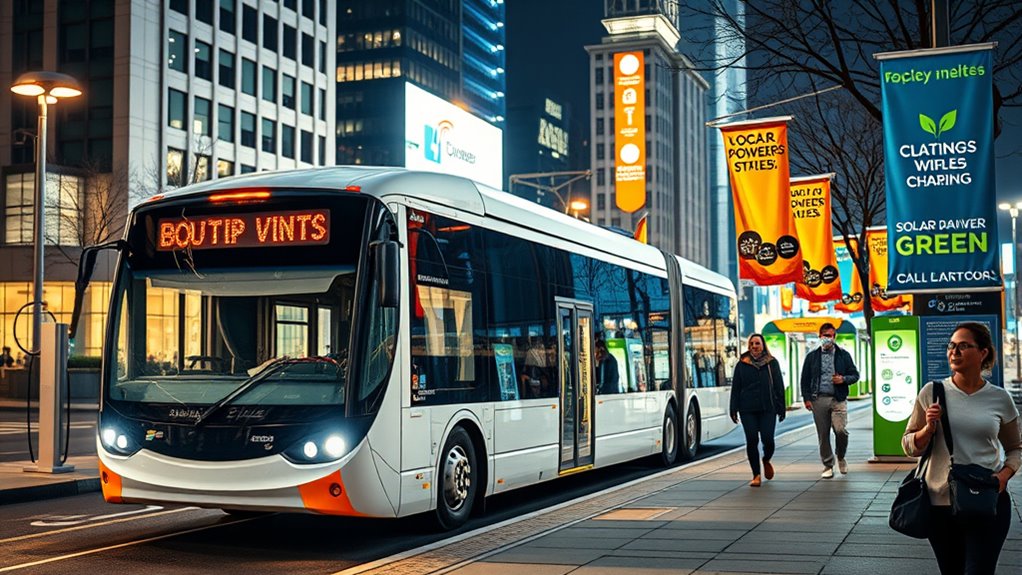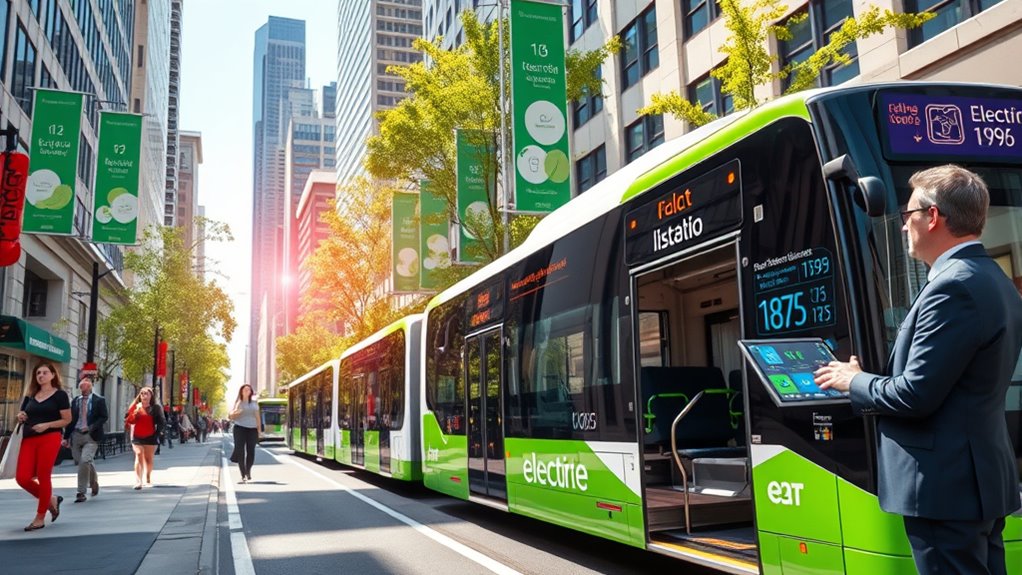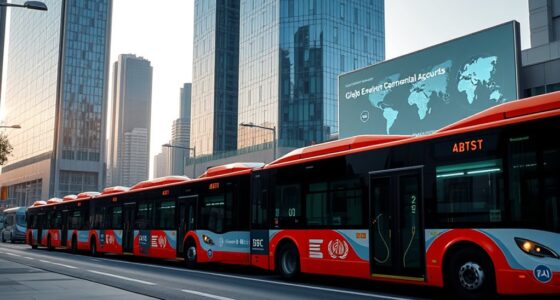Local policies drive electric bus adoption by setting clear goals, providing financial incentives, and supporting infrastructure development. They motivate transit agencies and schools to prioritize electric options while fostering community engagement to guarantee equitable access. These policies also influence industry investments and innovation, creating a more sustainable transportation system. By understanding these strategies, you’ll see how policies shape a cleaner, healthier future—stay with us to explore how these efforts are making an impact.
Key Takeaways
- Local policies set specific targets and roadmaps, guiding transit agencies and schools toward electric bus adoption.
- Financial incentives and infrastructure support lower high costs and enable operational success of electric buses.
- Policies influence market signals, encouraging manufacturers and industry investment in electric vehicle production.
- Community engagement strategies ensure diverse stakeholder input and public support for electric bus initiatives.
- Equity-focused policies promote deployment in high-need areas, track progress, and align with broader sustainability and health goals.

Local policies play a vital role in accelerating the adoption of electric buses by setting clear targets, offering financial incentives, and engaging communities. When local governments establish specific goals for electric bus deployment, they create a roadmap that guides transit agencies and school districts toward sustainable transportation. These targets serve as benchmarks, motivating agencies to prioritize electric vehicles and align their budgets accordingly. By clearly articulating these commitments, communities can also attract additional support from state and federal programs dedicated to clean transportation initiatives.
Financial incentives are key drivers in making electric buses more accessible. Grants, subsidies, and funding programs like the Clean School Bus Program help offset the high initial costs associated with purchasing electric buses. When local policies include such incentives, they reduce the financial barriers faced by transit authorities and schools, making the switch more feasible. These incentives also extend beyond vehicle purchase; they often support infrastructure development, such as installing charging stations, which is essential for operational success.
State legislation in places like New York, Connecticut, Maryland, and Maine demonstrates how policies can set electrification targets that influence market signals, prompting manufacturers to produce more electric buses and encouraging districts to adopt them. Additionally, effective policies often incorporate stakeholder engagement strategies to ensure that community voices are heard and that diverse needs are addressed in planning processes. Engaging local residents and organizations helps foster trust and promotes a sense of shared responsibility for environmental goals.
Community engagement is another critical element that local policies foster. When communities understand the health, safety, and environmental benefits of electric buses, public support grows. Advocacy from residents and local organizations creates demand, pressuring policymakers and transit agencies to prioritize electric options. Moreover, public awareness campaigns can further inform and motivate community participation in transportation initiatives.
Policies that emphasize equitable distribution ensure that electric buses reach high-need areas, such as rural or low-income communities, where air pollution and health disparities are most acute. This focus not only addresses environmental justice but also builds broader community buy-in, which is essential for successful policy implementation.
Long-term policy commitments send important market signals, encouraging manufacturers to increase production and invest in innovation. These commitments also help local agencies plan budgets and projects, knowing that their investments are part of a larger strategic effort. Moreover, integrating innovative technologies into transportation planning can further enhance efficiency and sustainability.
Establishing measurable targets allows policymakers to monitor progress, make necessary adjustments, and ensure accountability. Additionally, integrating water-related considerations into transportation planning can further support sustainability goals by promoting eco-friendly infrastructure and reducing environmental impact. This structured approach ultimately accelerates the transition to cleaner transportation, aligning local efforts with broader climate and health goals.
Frequently Asked Questions
How Do Local Policies Impact Electric Bus Maintenance Costs?
You might wonder how local policies influence electric bus maintenance costs. Policies that provide warranty extensions, service agreements, and funding incentives reduce your upfront expenses and ongoing costs.
Support for infrastructure upgrades and training helps prevent delays and lowers repair costs. Additionally, regulations encouraging utility partnerships and off-peak charging can cut energy expenses.
What Funding Sources Support Local Electric Bus Programs?
You find funding for local electric bus programs through federal grants like the EPA Clean School Bus Program and FTA grants, state incentives such as California’s HVIP and utility rebates, and local sources including municipal bonds and school district budgets. Public-private partnerships, nonprofit collaborations, leasing models, and innovative financing mechanisms also support adoption. These diverse funding streams help overcome costs, making electric buses a practical, sustainable choice for your community’s transportation needs.
Are There Specific Incentives for Private Operators?
You’re wondering if there are specific incentives for private operators. Currently, most policies focus on public sector buses, but governments are working on incentives tailored for private operators.
These could include tax breaks, grants, or shared charging infrastructure. Such incentives aim to reduce high upfront costs and encourage private companies to adopt electric buses.
Helping to expand clean transportation options and boost overall electric mobility.
How Do Policies Influence Electric Bus Infrastructure Development?
You see, policies shape electric bus infrastructure development by offering financial incentives like tax credits and grants that lower installation costs. They also set planning frameworks that ensure proper site placement and standards for charging hardware.
These policies provide operational support and enforce safety, making it easier and more attractive for you to develop a reliable, extensive charging network.
They also include regulatory tools like zoning laws and emission rules that streamline permits and push for fleet electrification.
What Are the Long-Term Economic Benefits of Policy-Driven Adoption?
You mightn’t realize it, but policies that promote electric bus adoption can transform your city’s economy.
Over time, you’ll see massive savings from lower maintenance and energy costs, making transportation more affordable.
These policies also attract investments and provide incentives that boost job creation.
Conclusion
Your city’s bold policies are transforming transportation and setting a global example. By embracing electric buses, you’re not just reducing emissions—you’re leading a revolution that could save the planet from disaster. Every bus on the road is a powerful step toward cleaner air and healthier communities. Keep pushing for change; your actions are making history in the fight against climate change. Together, you’re proving that local policies have the power to change the world.









